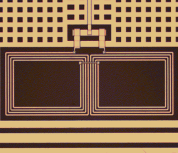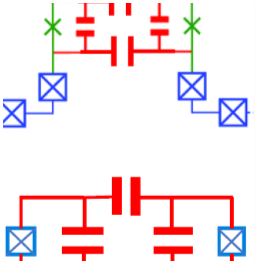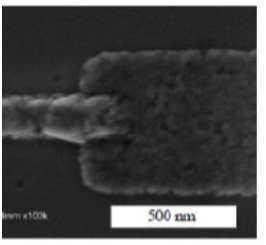Circuits with Two Quantized Levels for quantum computing:
Superconducting resonators and qubits, often enabled by quantum materials, are studied to better understand their potential performance in future quantum computers. Most studies focus on resonator coherence, using different types of amorphous nitride and oxide dielectrics as well as phase-textured nitride and aluminum superconductors. By definition qubits have two-levels, but this group especially develops methods to characterize material-based two-level systems (TLSs) as sources of qubit decoherence (defects). In the circuit from the adjacent figure, TLSs were first brought into resonance with a microwave resonator in a demonstration of a new Cavity-QED system. In another circuit study, TLSs are manipulated coherently with energy sweeping to allow net population inversion of TLSs despite their random nature. This enables a new microwave laser from the stimulated emission from random-systems (TLSs). These studies focus on coherence, individual TLSs, kinetic inductance, phase noise, etc.
Reversible Fluxon Logic:
Industry-standard digital logic uses irreversible gates whose energy dissipation is reaching a known minimum. Physics allows a fundamentally more-efficient alternative using complex systems with reversibility. We have developed a novel approach in our group that uses the inertia of flux quanta, rather than continuous adiabatic power. In this work, long Josephson junctions (LJJs) are used as fluxon media, which allow for two degenerate topological solitons as bit states. Complex nonlinear resonances between the ends of undamped LJJs and other undamped circuit elements allow for phenomena which are the subject of investigations. According to theory, the system allows a novel change in fluxon polarity (topological charge) using energy only from incoming fluxons (without adiabatic waveforms). This allows logic gates because the bit states are represented by fluxon polarity. A collective-coordinate model with pairs of solitons and mirror-antisolitons has allowed physical analysis of the gates (see adjacent figure). The gates are the subject of new macroscopic-quantum theoretical and experimental studies.
Defect Spectroscopy in Qubits
A Josephson junction is sometimes called the nonlinear circuit element enabling superconducting qubits. The nonlinearity allows usage of two states for quantum-state manipulation. We are currently studying individual quantum defects in special resonators. In the new project we will tune the defects in qubits, independent of the qubit tuning, which is quite new an extraordinary. This will allow us to look at defects individually in new ways. Generally, this will allow a new understanding of a defects in a JJ that is only now possible with the advent of new quantum-sensitive probes. The key advancement in the field is to enable electric-field tuning of the defects; this can be combined with magnetic tuning of the qubit.
|






